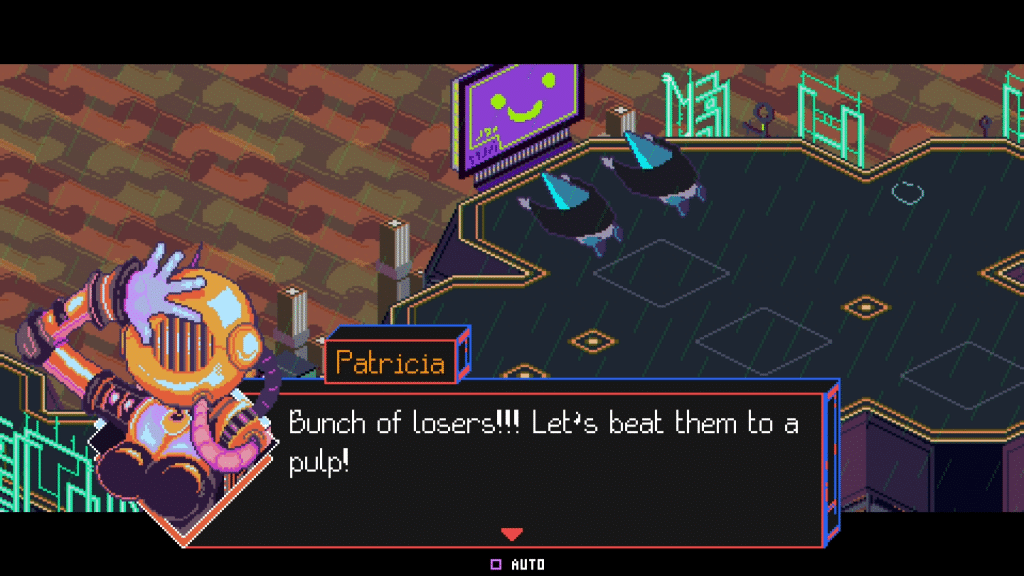At this point it’s hard to make a new experience. Either a game with any passing similarities becomes the Zelda, Mega Man, Splatoon, Soulsborne, and so forth game; or it’s expected to hit the ground running and forge a new path forward. These increasingly high expectations have resulted in AAA titles sticking with what works, leaving Indies to figure it out. Among the more interesting is Keylocker. Instead of jumping on the roguelike train, or picking its own classic, it tries to combine the RPG genre with rhythm mechanics. We’ve seen this work in the past, so can Moonana find the groove, or is it uncharted territory for a reason?
Keylocker starts by introducing a rather cryptic world. Players control Bobo, a rebellious girl that can make music. This is a crime of the highest order due to the electrical energy it can generate, an invaluable resource that capitalists of the past managed to hoard to amass untold power.

Contrary to the heavier nature this type of narrative brings, Keylocker keeps things light by relying on its own vibe. There are walrus people, alpacas are fighting for more ice cream, a t-rex manages save files, and it all snowballs from there. It also relies on more modern slang, like a rather liberal use of bro, which at least works better than another recent experience.
While the narrative takes a minute to get going, the real highlight is the world itself. Random enemies like vultures have their own say, as does practically everyone Bobo comes across. It captures that pre-3D RPG experience that encouraged people to talk to everyone they came across.

Alpaca Rights Matter
Bobo can also build a relationship with select characters, even have optional interactions, that push the narrative forward. The selected class at the beginning also promises some changes to the story. These little things urge players to continue exploring this world to see everything it has to offer, assuming you have the moves to make it work.
On paper Keylocker is incredibly straightforward for an RPG. Bobo starts by having a melee attack, and a buff that generates energy used to power the aforementioned strike. From there, every action asks players to input commands at the correct time.

Initially this is limited to watching a character flash white, before evolving into timing a strike (think golf power slider), or quickly inputting a random sequence. Surprisingly, these commands feel unforgiving, even on the lowest difficulty setting. Each move seems to have its own margin of error as well.
Despite sounding simple on paper, Keylocker basically expects a fair amount of proficiency to be successful. A single mistimed input can easily result in a character losing more than half their health. As gameplay evolves, it wasn’t uncommon for this to snowball as well.

One of the most common points of failure were counterattacks. These can be performed on either side, have their own input that can negate damage if done correctly, and are guaranteed in response to a hostile action. Messing this up just before an enemies turn can easily result in what feels like an instant death.
All of this makes Keylocker feel unforgiving, something that continues to grow as enemies become more diverse. Overtime it gets better, like I started using my MM-100 to listen for audio cues, which made the timing a lot easier than the visual indicator. Failure is also not the end of the world either. Losing simply offers another go at the fight, the option to load a save, or to give up (I think it loads the auto save).
Outside of fights is a surprisingly interesting world to explore. A number of charming interactions, optional events, or unique experiences are hidden in each town. One of my favorite examples happens early on with Big Foot Joe. He wants you to fix a vending machine, prompting a rather difficult fight against this surprisingly powerful, at the time, enemy.

It makes things far more interesting than simply following a linear path. At times the optional paths will be inaccessible with current resources, or require players to progress in something first. These can be some of the most exciting as they tease potential rewards hidden beyond seemingly incomprehensible puzzles.
Another thing that really stands out about Keylocker is the art style. I don’t think pixel art with an ’80s palette will resonate with many players, but I do think the attention to detail will stand out. Characters are detailed, complete with a wide array of charming details. The world is diverse and interesting, not relying on a single approach. Even several of the scenes take the art is a bold direction beyond the usual 2D visuals.
Keylocker Review Verdict
Keylocker: On a basic level I appreciate what Keylocker is going for. It's a stylish world that isn't afraid to use creativity to its advantage. This frequently results in memorable moments, eye catching designs, or experiences that take it in unexpected directions. The only downside is the core gameplay loop is not going to appeal to everyone. Harsh input windows, coupled with extreme damage for any mistake is going to turn off a lot of players. It's a shame too, as the core experience has a bit to offer for those willing to get past the first couple of bumps. – Grant
Editor’s Note: Keylocker was reviewed on PlayStation 5, and a copy was provided to us for review purposes.















